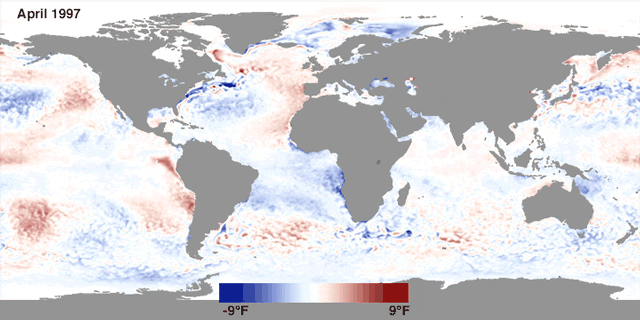News•January 19, 2014
Climate Change Could Double Likelihood of Super El Ninos

By Brian Kahn
The question of how global warming will influence El Niño has been a challenging one for scientists to answer. A new study suggests while the overall number of El Niños is unlikely to increase, particularly strong “super” El Niños are likely to occur twice as frequently in a warming world.
El Niño refers to a pattern of unusually warm water stretching across the surface of eastern equatorial Pacific that occurs every 3-7 years. That warm water influences climate patterns around the world, increasing the likelihood of wet and cool weather in the Southeast, heavy rain in California, warm and dry conditions in the Pacific Northwest, and host of other global impacts.
A map showing sea surface temperature anomalies leading up and during the 1997-98 super El Nino.
Credit: NOAA View

The strongest El Nino ever recorded occurred in 1997-98. It led to heavy rains across the southern U.S., landslides in Peru, wildfires in Indonesia, and the cratering of the anchovy fishery in the eastern Pacific. These and other impacts were responsible an estimated $35-45 billion in damage and 23,000 deaths worldwide.
Another “super” El Nino in 1982-83 wreaked similar havoc globally.
In a study published on Sunday in Nature Climate Change, researchers show that climate change could double the frequency of super El Nino events.
To obtain the results, researchers led by Wenjun Cai, a climate modeler at Australia’s Commonwealth Scientific and Industrial Research Organisation, used 20 climate models to simulate ocean temperatures and rainfall in the tropical Pacific with and without changes in greenhouse gases. Cai looked specifically at the period of December-February, when El Nino tends to peak and its impacts are the most widespread.
“Under greenhouse warming the eastern equatorial Pacific warms faster than the surrounding regions . . . making it easier to have maximum SST (sea surface temperatures) in the eastern equatorial Pacific, and hence more occurrences of extreme El Nino events,” Cai said in an email.
Surface waters in the eastern tropical Pacific averages around 72°F, about 10°F cooler than the western tropical Pacific. Cai said that makes it easier to warm, which reduces the overall temperature difference between the two regions and makes conditions more ripe for super El Ninos to develop.
Specifically, the results show that the likelihood of super El Ninos doubles from one every 20 years in the previous century to one every 10 years in the 21st century.
While the results show an increase in the number of abnormally strong El Ninos, they don’t show a change in the total number of El Ninos. The study also shows that the the current influence El Nino has on weather elsewhere is unlikely to change. Both are results that other studies have found as well.
The core of Cai’s results, that more super El Ninos are likely, was disputed by Kevin Trenberth, a senior scientist at the National Center for Atmospheric Research.
He said some of the models used in the study overestimate the past number of El Nino events by a wide margin and do a poor job of representing them and their impacts.
A dust clouds descends on Melbourne on February 8, 1983, a super El Nino year. El Nino tends to increase the likelihood of drier than normal conditions in eastern Australia.
Credit: Trevor Farrar/Australia Bureau of Meteorology

“This seriously undermines the confidence that the models do an adequate job in ENSO (El Nino-Southern Oscillation) simulations and so why should we trust their future projections?” he said in an email.
Trenberth also said that some long-range climate models also fail to adequately simulate other natural climate patterns that influence El Nino let alone how they might also shift in a warming world.
Lisa Goddard, director of the International Research Institute for Climate and Society provided a similar assessment of some of the models used in the study. However, she said the methodology was sound and if the results are accurate, they could provide helpful information for scientists making seasonal forecasts around the globe and decision makers who rely on them.
“Since the majority of skill in seasonal forecasts is realized during El Nino events (and predictions become more skillful over more of the world's land areas), we would be able to prepare much better for the impacts of these events,” she said. “Adverse and costly climate happens in all years. We are just better able to predict that in years with strong El Nino and La Nina events.”
Though the the 1997-98 super El Nino caused extensive damage, decision makers in California poured an extra $7.5 million into flood preparedness based on seasonal forecasts that accurately predicted it months ahead of time. The state still suffered $1.1 billion in losses during the event, but that was half the total suffered during the 1982-83 super El Nino.
Water managers in Tampa Bay regularly use seasonal forecasts and the predictability of El Nino to plan for water availability in the coming months.
There is evidence that El Ninos has been changing already. Research published in January last year showed a roughly 20 percent increase in El Nino intensity over the course of the 20th century, though it didn’t specifically attribute that change to human greenhouse gas emissions.
Related content
Global Warming-El Nino Link Stronger but Still Not Proven
NOAA’s New Cool Tool Puts Climate on View for All
Global Warming May Worsen Effects of El Niño, La Niña Events
El Nino May Be On the Way, Altering Weather Patterns
Forecasts Call for Weak-to-Nonexistent El Nino This Winter
Drought Has Ties to La Nina, with Global Warming Assist
